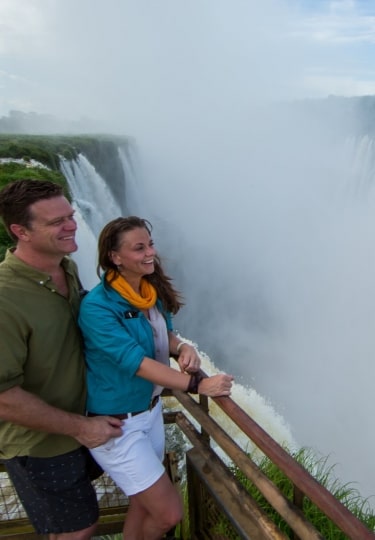Thanks to its wild and rugged terrain, South America has some of the largest and most impressive waterfalls in the world. If you’re headed down south, discover famous South America waterfalls like Iguazú Falls, an extensive system of over 200 waterfalls located on the border between Brazil and Argentina.
Venture to lesser-known cascades like Cascada Apoquindo, hidden in the jungle west of Santiago, Chile. Or spend the afternoon wading in a waterfall’s pool just outside of vibrant Rio de Janeiro. From towering cataracts to gentle cascades, here are the ten best waterfalls in South America.
Petrohue Waterfall, Chile
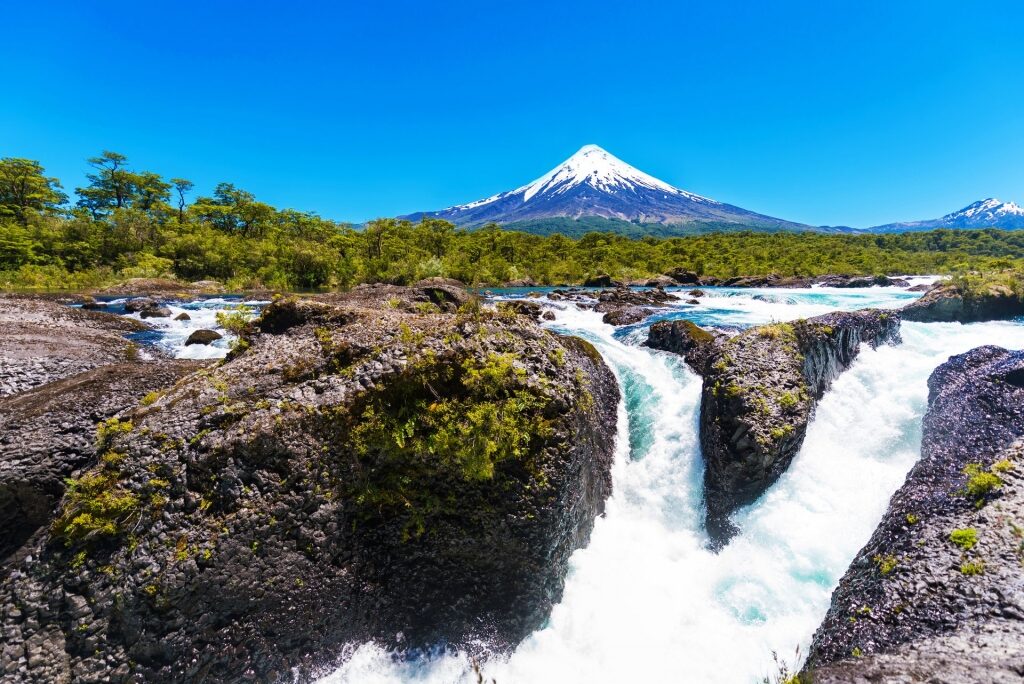
Petrohue Waterfall, Chile
One of the most famous waterfalls in South America is Petrohue Waterfall, located in the wilderness around Chile’s Puerto Montt. Petrohue isn’t as tall as Iguazú Falls but features one of the most stunning backdrop scenes in the world. With the Osorno Volcano in the background, Petrohue is a photographer’s dream, especially in the spring when the water is rushing at high speeds.
Petrohue Falls is part of the protected Vicente Perez Rosales National Park, where you’ll also find endless photo opportunities, multiple volcanoes, and some of the best hiking trails in Chile. The walks in the park are mostly flat, therefore it’s a wonderful place to spend time outside, regardless of your athletic ability. The park is only about an hour from Puerto Montt, making it easy to visit Petrohue Waterfall even if you only have a day or two to spend in the city.
Horto Waterfalls, Brazil
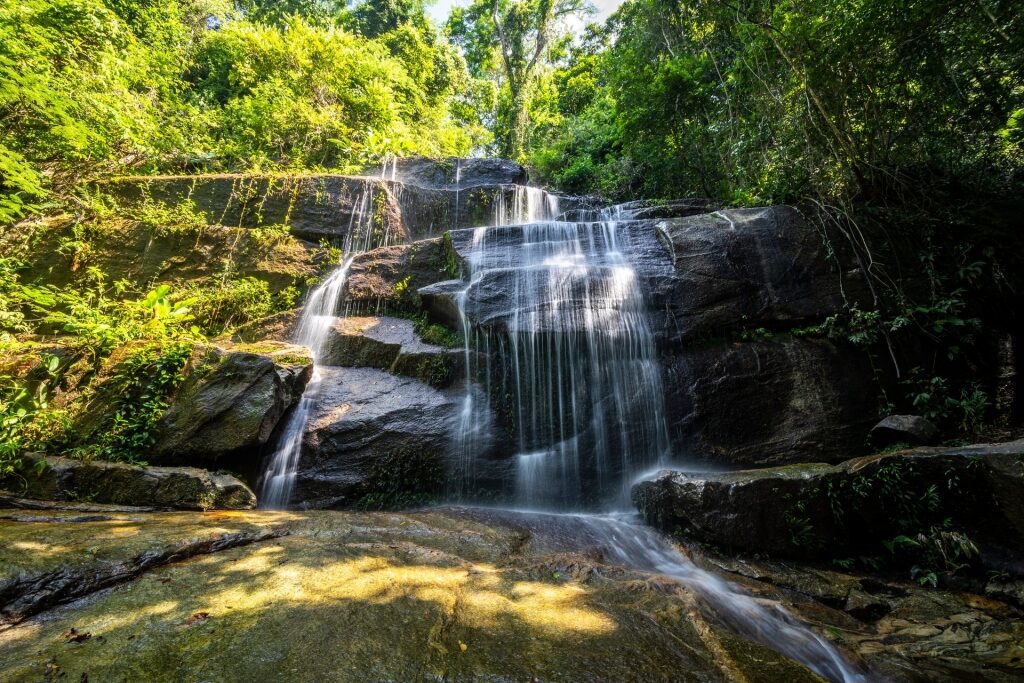
Horto Waterfalls, Brazil
If your idea of the perfect South American waterfall is less about the scale and more about the interactive experience, plan on visiting Horto Waterfall near Rio De Janeiro, Brazil. The falls are located within the Tijuca Forest, a rainforest park just 15 minutes from the city center. You’ll have to take a short walk through the jungle to reach them, but as long as you wear shoes with a good grip, you shouldn’t have trouble getting to the first falls.
If you’re dreaming of soaking your toes in a waterfall-fed pool (or even standing beneath the falls), Horto’s pool is small enough to allow visitors to safely wade in. Also, the pool is no more than hip-high at its deepest points.
If you’re feeling adventurous, you can continue on some of the wilder paths to find more falls and swimming holes. The first waterfall you’ll encounter at Horto is usually the most crowded, so the further you’re willing to walk, the more space you’ll find to yourself. Other popular falls in the park include the Taunay Cascade and Cascatinha Waterfall. You can also visit various lookout points, gardens, a restaurant, or even take a train to the famous Christ the Redeemer statue atop one of the park’s highest points.
Salto Grande, Chile
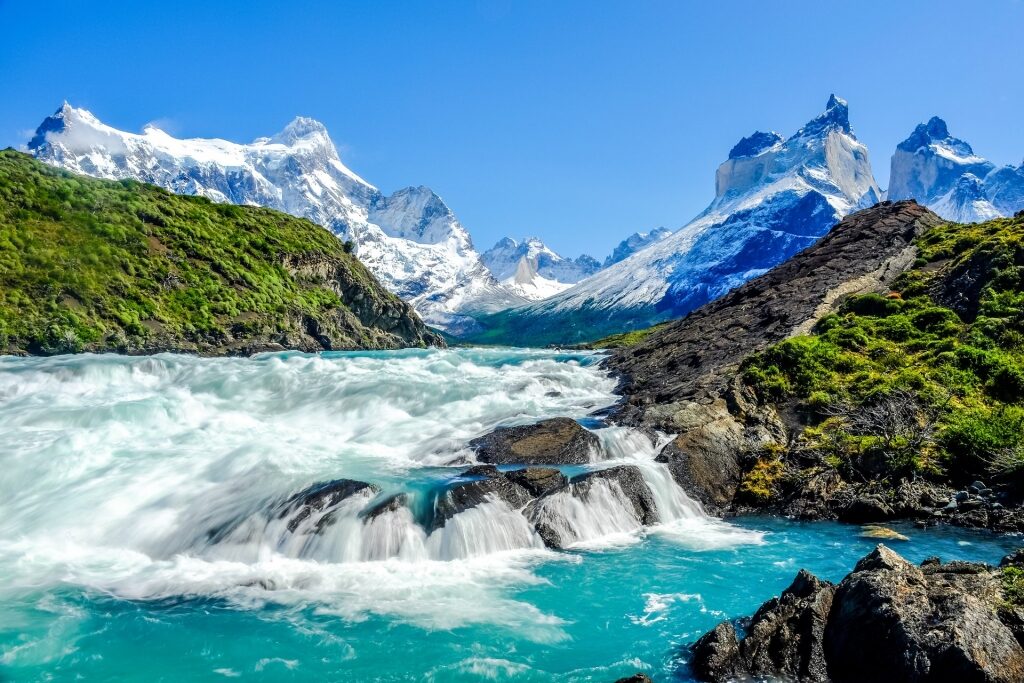
Salto Grande, Chile
Torres del Paine National Park is one of the most well-known parks in South America. It’s visited by hundreds of thousands of travelers every year, who are drawn to the park’s namesake trio of granite peaks. Aside from the towering main attraction, the park is also home to one of the best waterfalls in South America: Salto Grande.
Reaching Salta Grande is easy and accessible. Embark on a 1.2-mile-long hike along a park path that has only a bit of moderate elevation gain at the very end and you’ll reach the best viewpoint of Salto Grande. From there, you’ll see lovely views of the falls and the surrounding terrain.
You’ll notice the water of Salto Grande is a beautiful light blue because of the silt in the surrounding terrain. During a visit to Salto Grande, you’ll also spot wild guanacos, a Patagonian animal that resembles a llama, in the distance. If you’d like to embark on a more complex hike, there’s no shortage of challenging, multi-day paths to explore in the park, too.
Read: Visit Patagonia
Toca Waterfalls, Brazil
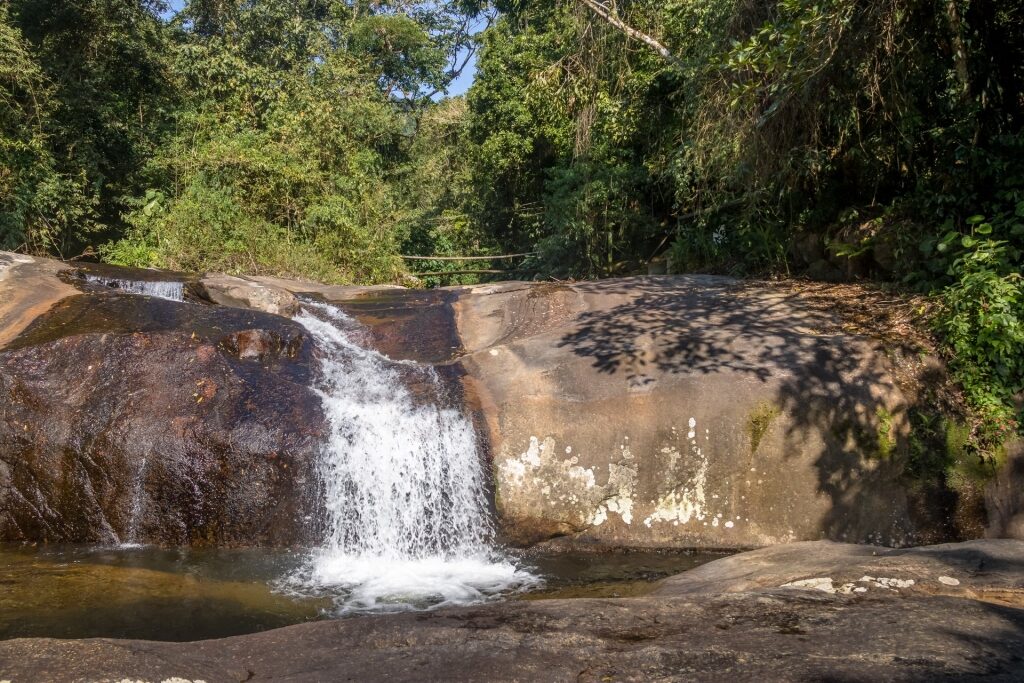
Toca Waterfalls, Brazil
The Toca Waterfalls are the epitome of a perfect jungle escape. The three falls that make up the Toca Waterfall system are tucked away in a forest outside Ilhabela, Brazil, on the Ilha de São Sebastião (Island of St. Sebastian). Rather than plunge down a multi-story descent, these short waterfalls cascade down large boulders, allowing you to swim in the watering holes at the foot of each fall.
Though the falls are located deep within the jungle, accessing them is far easier than expected. After a beautiful drive through the jungle, take a quick hike along a mostly flat terrain to reach this stunning natural attraction. Along the way, expect to see a bounty of colorful insects and South American birds.
The site of the falls used to be part of a sugar plantation in the 1930s, and while it’s now mostly used as a recreational site, you can still experience its sugar history in the small gift shop at the start of the trail, where you can try Brazilian cachaca.
This is one of the best South American waterfalls to visit if you want to squeeze in some light physical activity and still leave some free time in the late morning or afternoon to enjoy a few hours of beach time.
Iguazú Falls, Argentina
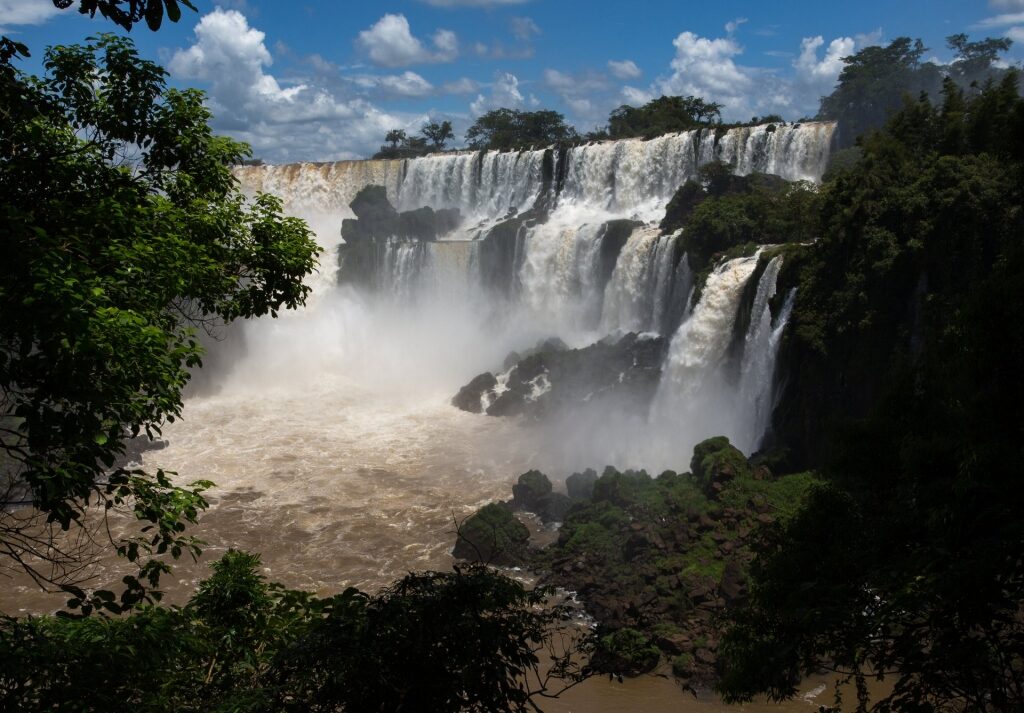
Iguazú Falls, Argentina
There’s a reason why Iguazú Falls is one of the most famous waterfalls in South America. With more than 300 waterfalls on the 8,858-foot wide cliff band, Iguazú Falls are more than double the width of Niagara Falls.
Iguazú Falls is located on a national park that straddles Brazil and Argentina. It was declared a UNESCO World Heritage Site in 1984 and a “New Wonder of the World” by the Seven Wonders Foundation in 2011.
At this wild and remote site, the adventure begins hours before you reach the falls. First, take a small flight over the jungle to Puerto Iguazú. From there, you’ll head to the park, where you’ll be able to explore a variety of nature trails and walk across over-the-water catwalks. You can also take a boat ride along the river or go on a wildlife tour on your way to the falls, where you might come across toucans, wild birds, coatimundi, or even a tapir cooling off in the riverbeds.
Gato Waterfall, Brazil
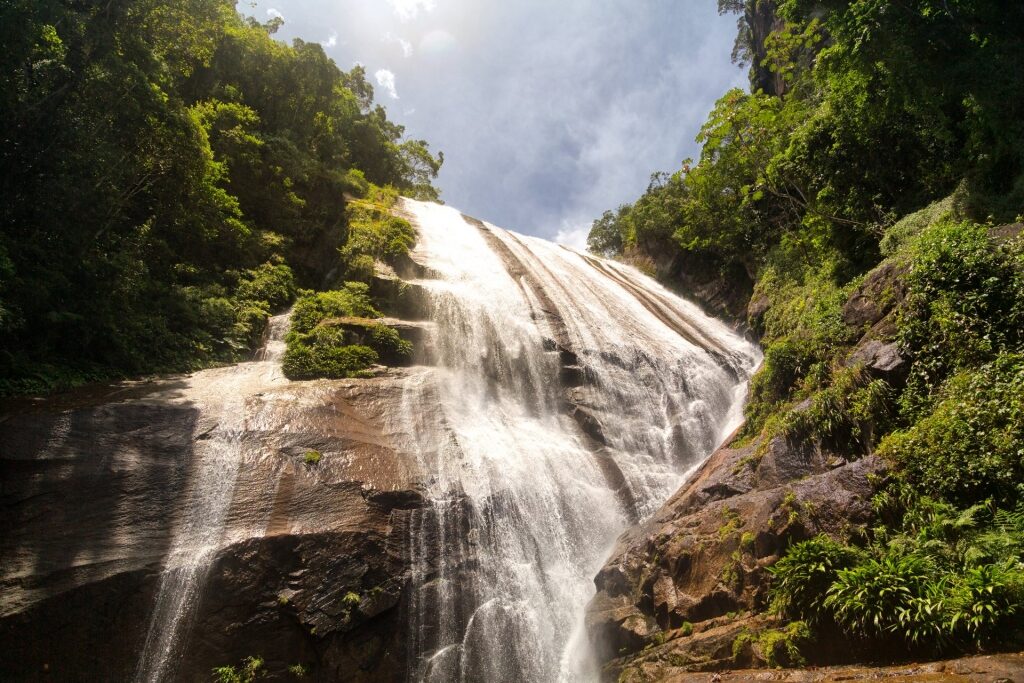
Gato Waterfall, Brazil
Gato Waterfall, which translates to the “cat’s waterfall,” is also located on Ilha de São Sebastião, near Castelhanos Beach. It’s only about a 15-minute walk through the jungle, making it a great waterfall option to visit in the morning. The falls are around 200 feet tall, so swimming in the pools is generally not recommended unless you come in the middle of the dry season. If you are more interested in marveling at a towering waterfall, rather than swimming at its base, it makes more sense to visit this waterfall instead of Toca Falls.
While Cachoeira do Gato is the primary waterfall, there are several other falls in the area to explore as well. The island has more than 350 waterfalls across its 210 square miles. Most of the inland area of the island is inaccessible by car and protected for its ecological value, but the beaches on the western side of the island are developed and are a popular destination with weekend travelers coming from the mainland.
Cachoeira dos Tres Tombos, Brazil
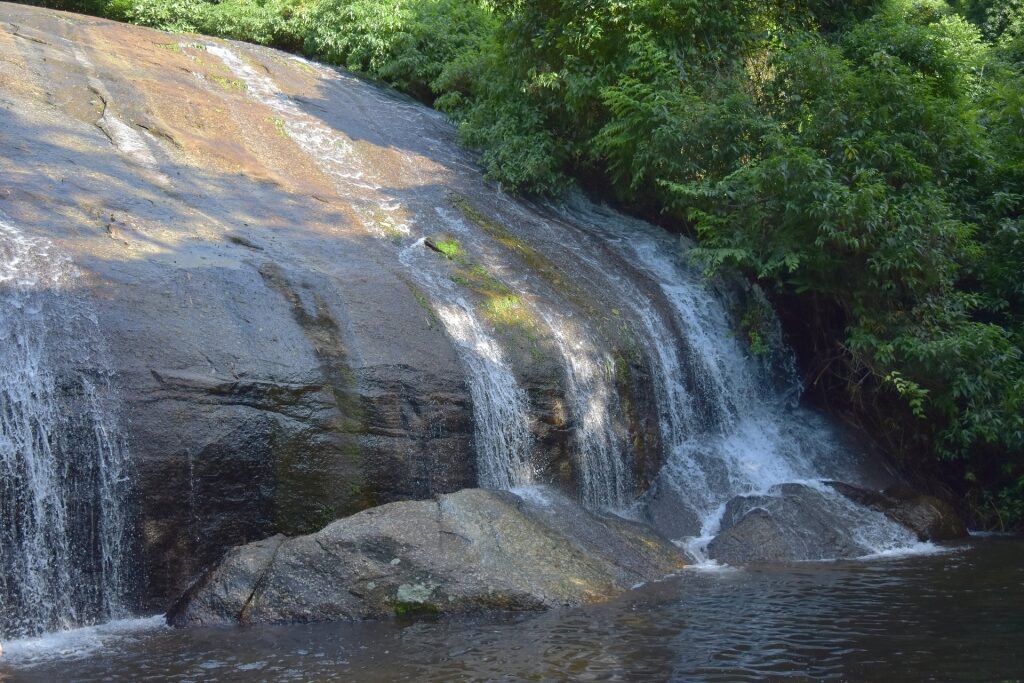
Cachoeira dos Tres Tombos, Brazil
Not too far from Brazil’s popular Curral Beach, you’ll find Cachoeira dos Tres Tombos, which roughly translates to “waterfall of three tumbles.” Since it’s relatively close to the coast, it doesn’t take very long to reach, making it an excellent addition to a day of sightseeing on Ilhabella’s western side.
Cachoeira dos Tres Tombos is approximately 65 feet tall, but because the water cascades across rocks, the stream is gentle enough to stand under and experience an authentic jungle shower. If you don’t want to swim, there are plenty of places to relax next to the pools and enjoy the waterfall’s cooling spray and mist.
Be warned: the road to the falls can get a bit bumpy. Some tour operators use ATVs or open-air vehicles to transport guests to the site, which adds a bit of extra adventure to the excursion.
Cascada Apoquindo, Chile
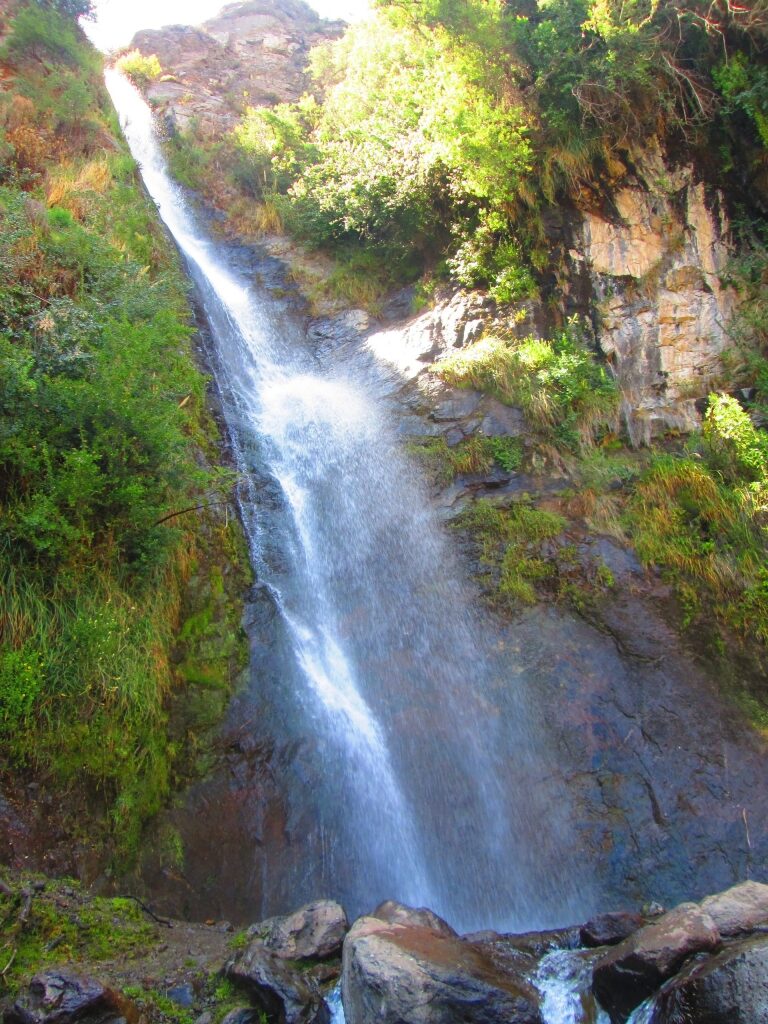
Cascada Apoquindo, Chile
Chile’s Apoquindo Waterfall is located in San Carlos de Apoquindo Natural Park at the base of the Andes, just east of the city of Santiago. There are several parks in this area, including the popular Aguas de Ramón Natural Park and Puente Ñilhue Natural Park.
The long hike to reach the Cascada Apoquindo viewpoint is best for experienced and healthy hikers. The trek is roughly 11 miles round-trip and gains around 2,600 feet of elevation. The safe bet is to embark on a guided trip if you’re not familiar with trail navigation and basic backcountry safety. You’ll find various adventure tour operators in Santiago that run day trips to the falls. The parks collectively have dozens of miles of hiking trails that offer plenty of alternate options if you’re looking for a shorter stroll.
Salto Del Agua, Chile
If you’re anxious to stretch your legs while in Valparaiso, Chile, consider a quick trip to Salto Del Agua in Placilla. The small town is just 15 minutes south of Valparaiso and easy to reach by taxi or public transport. Towering more than 250 feet high, the waterfall is quite impressive and is one of the best South American waterfalls near an urban area. The trailhead is located only about a 15-minute walk from the traffic roundabout in central Placilla.
The trailhead begins at the entrance of the municipal forest. From there, it’s another 1.5 miles along the park trails to reach the falls viewpoint that is called the Mirador Salto del Agua.
Los Amigos Waterfall, Argentina
If you find yourself in Ushuaia, the capital of Tierra del Fuego, consider heading to Los Amigos Waterfall, which is familiarly known as the “Cascade of Friends.” The trail to the waterfall starts at the northernmost point of Camino Arakur, where you’ll see a few parked cars, as well as a trail with informational signs. The ride from downtown Ushuaia to the trail takes no more than a few minutes in a cab, and most drivers are familiar with the trail’s starting point.
From the trailhead, it’s about 2.7 miles to reach the waterfall for a round-trip distance of just over five miles. The trail gains around 1,300 feet of elevation, but it’s mostly a gradual incline and should be doable for almost anyone with a little hiking experience. The trail can get muddy, especially towards the end as you parallel the river, therefore consider bringing waterproof hiking shoes and using hiking poles for stability in some of the trickier sections. The beautiful trail is well-marked and meanders through Tierra del Fuego’s spectacular forest landscape, allowing you to fully experience the region’s unique wilderness.
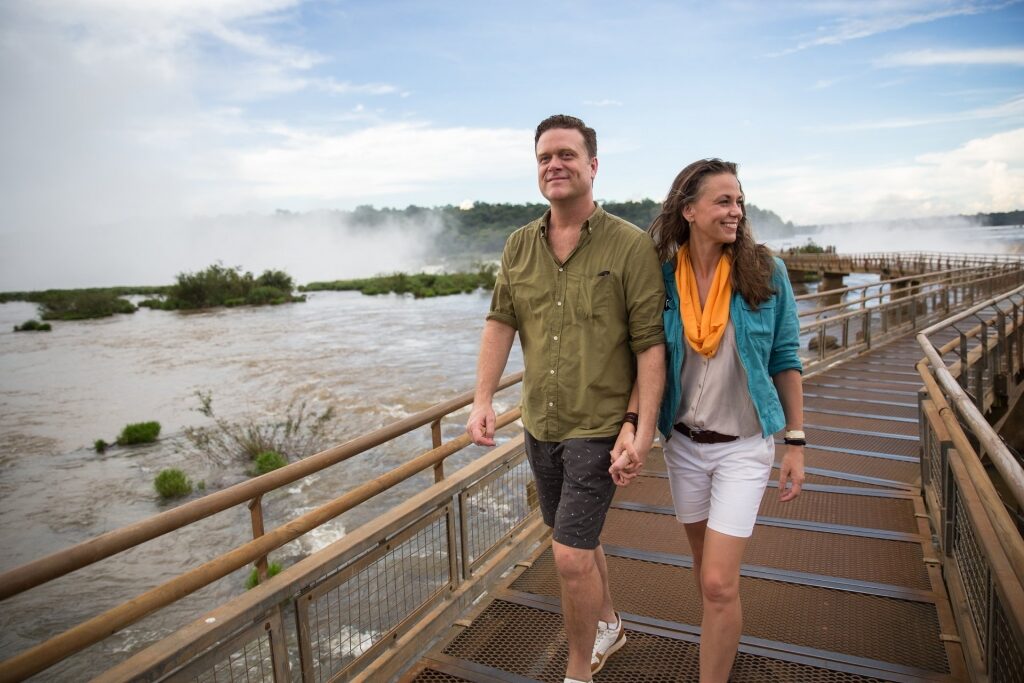
Iguazu Falls, Argentina
If you’re ready to discover some of South America’s best-kept natural treasures in person, browse our cruises to South America and get ready to embark on the vacation of a lifetime with Celebrity.
